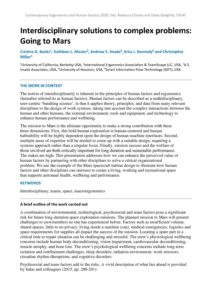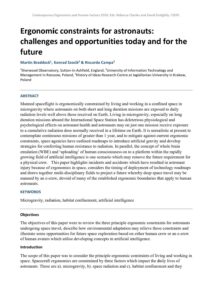Aerospace
Interdisciplinary solutions to complex problems: Going to Mars
| Document | Author Cristina G. Banks, Kathleen L. Mosier, Andrew S. Imada, Kriss J. Kennedy and Christopher Miller |
| Abstract The notion of interdisciplinarity is inherent in the principles of human factors and ergonomics (hereafter referred to as human factors). Human factors can be described as a multidisciplinary, user-centric ‘bundling science’, in that it applies theory, principles, and data from many relevant disciplines to the design of work systems, taking into account the complex interactions between the human and other humans, the external environment, tools and equipment, and technology to enhance human performance and wellbeing. The mission to Mars is the ultimate opportunity to make a strong contribution with these three dimensions. First, this bold human exploration is human-centered and human habitability will be highly dependent upon the design of human-machine interfaces. Second, multiple areas of expertise will be needed to come up with a suitable design, requiring a systems approach rather than a singular focus. Finally, mission success and the welfare of those involved are both critically important for long duration and sustainable performance. The stakes are high. This presentation addresses how we can enhance the perceived value of human factors by partnering with other disciplines to solve a critical organisational problem. We use the example of the Mars spacecraft habitat design to illustrate how human factors and other disciplines can intersect to create a living, working and recreational space that supports astronaut health, wellbeing and performance. |
Ergonomic constraints for astronauts: challenges and opportunities today and for the future
| Document | Author Martin Braddock, Konrad Szocik & Riccardo Campa |
| Abstract Manned spaceflight is ergonomically constrained by living and working in a confined space in microgravity where astronauts on both short and long duration missions are exposed to daily radiation levels well above those received on Earth. Living in microgravity, especially on long duration missions aboard the International Space Station has deleterious physiological and psychological effects on astronaut health and astronauts may on just one mission receive exposure to a cumulative radiation dose normally received in a lifetime on Earth. It is unrealistic at present to contemplate continuous missions of greater than 1 year, and to mitigate against current ergonomic constraints, space agencies have outlined roadmaps to introduce artificial gravity and develop strategies for conferring human resistance to radiation. In parallel, the concept of whole brain emulation (WBE) and ‘uploading’ of human consciousness on to a platform within the rapidly growing field of artificial intelligence is one scenario which may remove the future requirement for a physical crew. This paper highlights incidents and accidents which have resulted in astronaut injury because of ergonomics in space, considers the timing of deployment of technology roadmaps and draws together multi-disciplinary fields to project a future whereby deep space travel may be manned by an e-crew, devoid of many of the established ergonomic boundaries that apply to human astronauts. |


